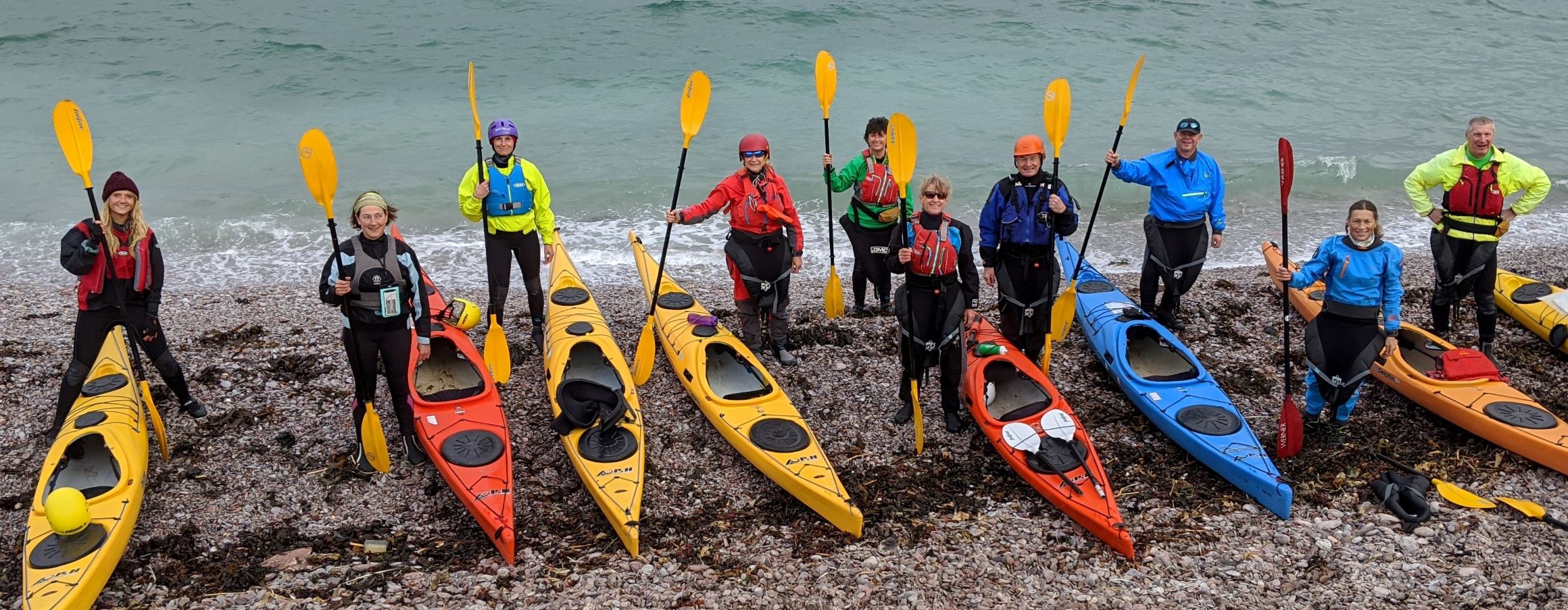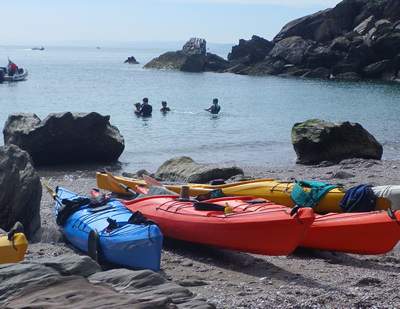Risk Assessment and Operating Procedures Document
This page details some of the risks in the Dart estuary and the area immediately outside but applies to all club paddles. It is acknowledged that kayaking is a risk sport and as such not all hazards/risks can be eliminated.
Leaders
Club paddles are led by a named leader, holding a current Coaching qualification, or a Leading qualification.
Risks:
Entrapment by Spray decks
Beginners should not wear a spray deck until they have carried out a satisfactory practice capsize and have demonstrated that they are able to release the spray deck whilst underwater.
Early directional instability causing beginners to drift into danger
Beginners will use the shorter sit in kayaks (eg Corsicas) which should have skegs fitted at the start. Forward paddling basics should be covered on land, and similarly how to turn, and how to stop, should be demonstrated before taking to the water.
Paddlers capsizing on launch
Paddlers should get into boats that are on the water, rather than being slid off the pontoon, to prevent capsizing at launch. Ideally, an assistant should be on the water first to hold their kayak as they sit into it.
Lower Ferry
The ferry reverses out of its slipway. Ferry drivers can see kayaks well when the ferry is going forwards but not when it is reversing. If the ferry has just arrived and the cars are still pointing to the shore, it is safe to go round the back as the ferry will not leave suddenly. Once cars are pointing away from the shore do not go round the back. Do not rely on there being no driver in the cab, they have been known to jump in and start reversing without looking. There are two recommended options
- Wait until the ferry leaves, then go past the slipway as a group (as soon as you can, so as not to delay the other ferry).
- Paddle out to the middle of the river, then turn and cross the line of the ferry in an area where the ferry driver is not reversing.
The Higher Ferry is less of a risk. It is, however, quite fast and to avoid disrupting its operation paddlers should generally keep very clear and pass behind, not in front of it.
Difficulty in returning to base due to tide or wind
Leaders have the knowledge, experience and skill necessary to plan paddles and will consider the experience and ability of the group before commencing a paddle. They also have knowledge of the tides and locality and are primarily concerned about keeping all paddlers safe, whilst delivering an enjoyable paddle.
Communication difficulties in event of incident
The Leader will carry a VHF radio on every paddle and have a least one other form of communciation, too (eg Mobile phone and/or a flare). Operating a VHF radio requires a licence, but any person, whether or not they hold a VHF certificate, can use a radio in an emergency.
Paddler disabled by minor injury or tiredness
Leaders will carry towlines (long and short) to assist an injured paddler who is unable to continue to paddle themselves. Additionally, Leaders will encourage others in the group to carry towlines and may delegate a tow to other group members. Towing and rafted tows are practiced regularly.
Paddler hit by weight or hooks cast by a fisherman
The most dangerous fishermen are unsupervised children! The safest way to go past an angler is close to the shore (to pass under the line) as knowing how far an angler can cast is difficult to estimate.
Collisions with other vessels
Generally, kayakers should keep to the edge of the river, rather than the centre. When crossing, they should do so as a single entity, putting the slowest paddler at the front of the group, to minimize the chance of the group spreading out.
Shoulder injuries
Shoulder injury is a constant risk for paddlers, as a paddle can have large forces acting on it, especially if the arm is extended. A slight bend at the elbow reduces the risk considerably.
Paddlers blown out to sea
Offshore winds carry the risk of being blown out to sea. In Dartmouth, being a natural harbour, the high cliffs usually provide some shelter to offshore winds. However, in strong winds, additional care should be taken near the castles when re-entering the river.
Area by Western Blackstone
When proceeding west outside the harbour, there is a sheltered area close to the cliff near the Western Blackstone. The final 100 metres of water between this area and the island itself is quite dangerous. It is exposed to a full westerly wind and care should be taken. Leaders will take care to keep the group together as they approach this area.
Tides
All members should be encouraged to understand how to use tide tables.
Sit on Tops (SOTs)
Users of SOTs are encouraged to view the several training videos covering towing and rescues and how to attach seats. They should ensure they have some form of communication with them (eg a mobile phone in a waterproof case).
VHF issues
Test batteries by turning radio on briefly before setting off. Do not leave the radio on, but keep it off and use for emergencies only. Do not use it for inter group chats. Leaders will carry their own but an additional radio should be taken by another person (eg the Assistant Leader) on the paddle, in case the group becomes split (or the Leader incapacitated). Radio check calls should be made regulary.
Manage the risks as appropriate to the circumstances
Leaders' knowledge and experience will help them to avoid undue risks to the group, and they will be alert to potential hazardous situations throughout a paddle. Consequently, a paddle may differ from that originally planned in response to a perceived increased risk. Leaders will adapt the paddle as necessary and appropriate.
Sea kayaking
General-purpose river kayaking Stand Up Paddleboards (SUPs)


